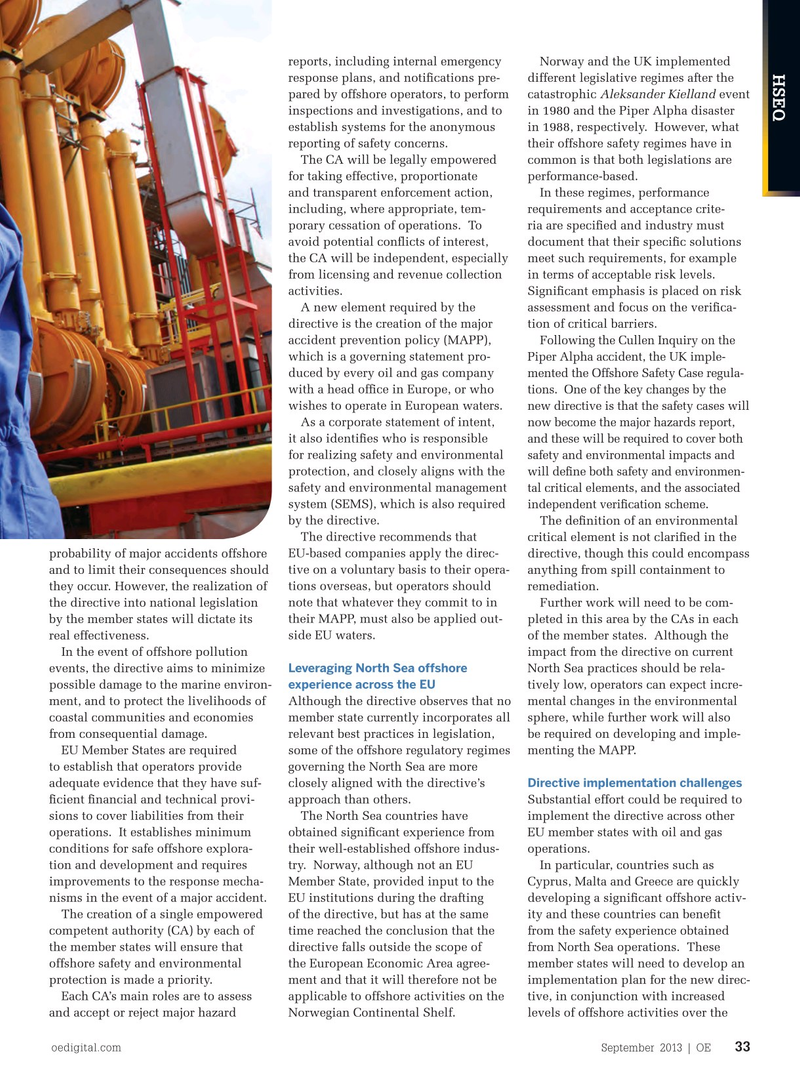
Page 31: of Offshore Engineer Magazine (Sep/Oct 2013)
Read this page in Pdf, Flash or Html5 edition of Sep/Oct 2013 Offshore Engineer Magazine
reports, including internal emergency Norway and the UK implemented
HSEQ response plans, and notifcations pre- different legislative regimes after the pared by offshore operators, to perform catastrophic Aleksander Kielland event inspections and investigations, and to in 1980 and the Piper Alpha disaster establish systems for the anonymous in 1988, respectively. However, what reporting of safety concerns. their offshore safety regimes have in
The CA will be legally empowered common is that both legislations are for taking effective, proportionate performance-based. and transparent enforcement action, In these regimes, performance including, where appropriate, tem- requirements and acceptance crite- porary cessation of operations. To ria are specifed and industry must avoid potential conficts of interest, document that their specifc solutions the CA will be independent, especially meet such requirements, for example from licensing and revenue collection in terms of acceptable risk levels. activities. Signifcant emphasis is placed on risk
A new element required by the assessment and focus on the verifca- directive is the creation of the major tion of critical barriers. accident prevention policy (MAPP),
Following the Cullen Inquiry on the which is a governing statement pro-
Piper Alpha accident, the UK imple- duced by every oil and gas company mented the Offshore Safety Case regula- with a head offce in Europe, or who tions. One of the key changes by the wishes to operate in European waters. new directive is that the safety cases will
As a corporate statement of intent, now become the major hazards report, it also identifes who is responsible and these will be required to cover both for realizing safety and environmental safety and environmental impacts and protection, and closely aligns with the will defne both safety and environmen- safety and environmental management tal critical elements, and the associated system (SEMS), which is also required independent verifcation scheme. by the directive. The defnition of an environmental
The directive recommends that critical element is not clarifed in the probability of major accidents offshore EU-based companies apply the direc- directive, though this could encompass and to limit their consequences should tive on a voluntary basis to their opera- anything from spill containment to they occur. However, the realization of tions overseas, but operators should remediation. the directive into national legislation note that whatever they commit to in Further work will need to be com- by the member states will dictate its their MAPP, must also be applied out- pleted in this area by the CAs in each real effectiveness. side EU waters. of the member states. Although the
In the event of offshore pollution impact from the directive on current events, the directive aims to minimize North Sea practices should be rela-
Leveraging North Sea offshore possible damage to the marine environ- tively low, operators can expect incre- experience across the EU ment, and to protect the livelihoods of Although the directive observes that no mental changes in the environmental coastal communities and economies member state currently incorporates all sphere, while further work will also from consequential damage. relevant best practices in legislation, be required on developing and imple-
EU Member States are required some of the offshore regulatory regimes menting the MAPP.
to establish that operators provide governing the North Sea are more adequate evidence that they have suf- closely aligned with the directive’s
Directive implementation challenges fcient fnancial and technical provi- approach than others. Substantial effort could be required to sions to cover liabilities from their The North Sea countries have implement the directive across other operations. It establishes minimum obtained signifcant experience from EU member states with oil and gas conditions for safe offshore explora- their well-established offshore indus- operations. tion and development and requires try. Norway, although not an EU In particular, countries such as improvements to the response mecha- Member State, provided input to the Cyprus, Malta and Greece are quickly nisms in the event of a major accident. EU institutions during the drafting developing a signifcant offshore activ-
The creation of a single empowered of the directive, but has at the same ity and these countries can beneft competent authority (CA) by each of time reached the conclusion that the from the safety experience obtained the member states will ensure that directive falls outside the scope of from North Sea operations. These offshore safety and environmental the European Economic Area agree- member states will need to develop an protection is made a priority. ment and that it will therefore not be implementation plan for the new direc-
Each CA’s main roles are to assess applicable to offshore activities on the tive, in conjunction with increased and accept or reject major hazard Norwegian Continental Shelf. levels of offshore activities over the oedigital.com September 2013 | OE 33 032_OE0913_HSEQ1_DNV.indd 33 8/18/13 8:19 PM

 30
30

 32
32